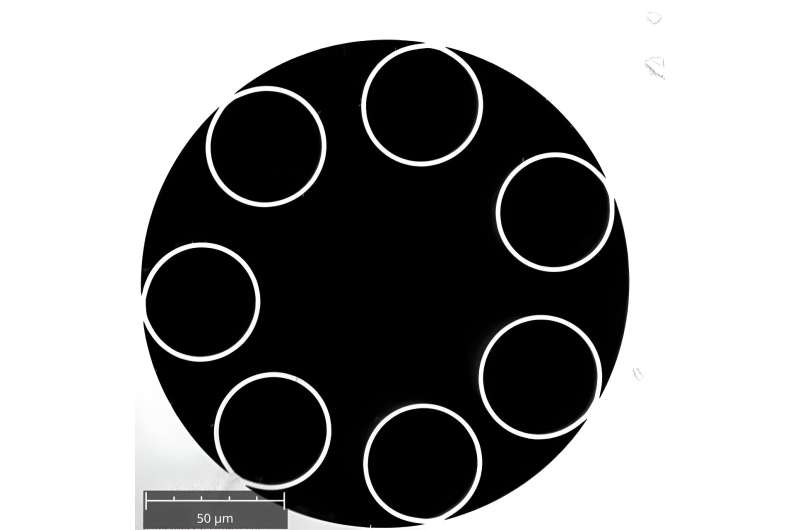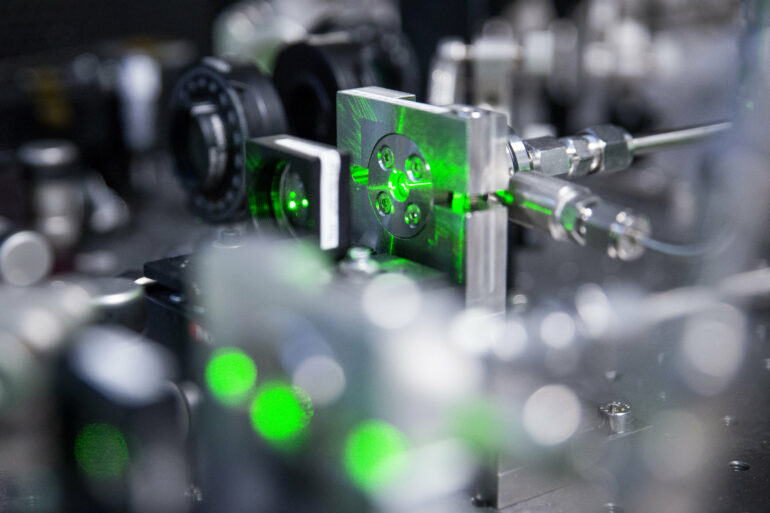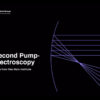Scientists led by Nanyang Technological University, Singapore (NTU Singapore) have developed a novel method to produce intense and ultra-fast lasers that holds promise for making precise devices that can speed up how quickly trace amounts of pollutants and hazardous gases can be sniffed out.
Currently, lasers comprising invisible light in the middle of the infrared range can be used to figure out in minutes what is in the air, whether it is greenhouse gas pollutants, toxic substances, explosives, or gases linked to diseases found in a person’s breath.
High-powered versions of the mid-infrared laser produced in ultra-fast spurts are critical because they underpin very sensitive devices that can safely detect, from a distance, even tiny amounts of a substance that would otherwise go unnoticed or prove tricky to identify.
However, ways to generate such lasers have drawbacks for now. One method requires laboratory conditions free from disturbances—like vibrations and even changes in temperature and humidity—that can misalign delicately calibrated equipment. This means the lasers cannot be used outside the lab.
Another method can produce the lasers while coping with environmental interferences such as vibrations, but their intensities are not strong enough to detect minute amounts of substances accurately.
These challenges have been addressed with new research by NTU Singapore-led scientists.
The researchers used specially made optical fibers with hollow cores, tweaking the thickness of sub-structures in the fibers to produce very bright lasers in the mid-infrared range of the electromagnetic spectrum.

Research fellow Dr Deng Ang from NTU Singapore’s School of Electrical and Electronic Engineering calibrating the optical equipment in an experimental set-up with a green laser. The set-up is used to generate intense and ultra-fast mid-infrared lasers. © NTU Singapore
“Our method paves the way for developing portable, powerful and fast mid-infrared laser generators that don’t need well-controlled and vibration-free environments to work,” said Nanyang Assistant Professor Chang Wonkeun, from NTU’s School of Electrical & Electronic Engineering, who led the latest research.
“This means we can pair them with a detector and use them in the field to help test and identify a wide variety of unknown substances on the spot and at the same time, even in trace amounts, without spending extra time sending samples to labs for testing.”
The research was published in print in Laser & Photonics Reviews.
Hollow-core fibers
Mid-infrared lasers, which have wavelengths of 2–20 micrometers, have advantages over other lasers in detecting substances.
Many different types of molecules absorb lasers in the mid-infrared range in unique ways, more so than lasers in other wavelengths, and this feature can be used to identify unknown substances. Also, even if water is present in these substances, the accuracy of using mid-infrared lasers to identify the substances is not affected by the water molecules, unlike with other lasers.
One method to produce high-powered mid-infrared lasers in very quick spurts is to shine bright and ultra-fast near-infrared radiation, which has a shorter wavelength, through optical fibers.

(From left) Research fellow Dr Deng Ang, Nanyang Assistant Professor Chang Wonkeun and senior research fellow Dr Trivikramarao Gavara from NTU Singapore’s School of Electrical and Electronic Engineering with the experimental set-up used to generate intense and ultra-fast mid-infrared lasers. © NTU Singapore
Fibers with solid glass centers produce mid-infrared lasers that are usually not powerful, which makes it difficult for small amounts of substances to be detected accurately.
To produce high intensity mid-infrared lasers, an environment free of interference is typically needed, which confines the use of the lasers to the lab.
Asst Prof Chang resolved these issues using glass fibers with hollow cores. He discovered this when he ran computer simulations to determine the types of radiation that could be produced when near-infrared radiation was passed through hollow-core fibers.
Unlike a traditional optical fiber, the tube-like hollow-core fiber’s inner wall has a ring of smaller glass tubes around the fiber’s empty center.
By changing the wall thickness of the fiber’s mini tubes, Asst Prof Chang’s simulations showed that converting the near-infrared laser into a powerful, ultra-fast mid-infrared laser was possible.
His team later conducted experiments which filled the hollow-core fibers’ centers with argon gas, and the scientists were able to confirm the simulations’ predictions. They produced mid-infrared lasers with wavelengths of 3–4 micrometers at peak power in the megawatt range, which is about a million times more powerful than a standard light bulb.
This laser conversion happens because the near-infrared laser interacts with the fiber’s shape, energizing the argon gas molecules and causing the laser to change to mid-infrared.

(From left) Research fellow Dr Deng Ang, Nanyang Assistant Professor Chang Wonkeun and senior research fellow Dr Trivikramarao Gavara from NTU Singapore’s School of Electrical and Electronic Engineering with the experimental set-up used to generate intense and ultra-fast mid-infrared lasers. Dr Deng is calibrating the optical equipment in the set-up with a green laser. © NTU Singapore
The thickness of the mini tubes correlates to slightly more than two times the wavelength of the mid-infrared laser generated. So, a mini tube with a wall thickness of 1.6 micrometers results in a laser with a wavelength that peaks around 3.7 micrometers.
Professor Sébastien Février from the University of Limoges, who researches mid-infrared lasers and was not involved in Asst Prof Chang’s study, said that the NTU team’s laser-generation method “is in striking contrast to the usual set-ups involving complicated non-linear arrangements.”
“Furthermore, since fibers can be spliced to each other, these results pave the way towards generating mid-infrared lasers free from any moving mechanical parts,” said Prof Février.
Based on experimental data, the researchers’ ultra-fast mid-infrared lasers are about 1,000 times more powerful than those produced by existing methods that use optical fibers with solid cores.
The lasers should be many orders of magnitude more powerful—potentially a million times—than the mid-infrared light currently used in handheld devices for detecting hazardous substances. Due to their low-powered mid-infrared light, these portable devices cannot detect substances more than 100 meters away.
“With a high-intensity laser, we can achieve high sensitivity and potentially use the laser in devices to safely detect even very small amounts of a substance that lasers or light produced from existing methods will have trouble with,” said Asst Prof Chang.
The scientists’ method for producing 3–4 micrometer mid-infrared lasers opens the way for developing more accurate and precise sensors for keeping tabs on the environment for pollutants and possibly for health monitoring.

A scanning electron microscope photo of the cross-section of a hollow-core fiber used in NTU Singapore’s mid-infrared laser experiments. A ring of seven smaller tubes can be seen along the inner wall of the fiber core. © NTU Singapore
Their lasers could be used to help identify greenhouse gases like methane that absorb mid-infrared radiation in this range well. And since methane found in a person’s breath has been linked to colorectal cancer, the lasers could also offer a way to monitor people’s health through breath analysis.
In the future, the scientists plan to do further research to produce mid-infrared lasers with longer wavelengths that are even brighter.
Asst Prof Chang believes his method could, in theory, produce mid-infrared lasers of up to 10 micrometers.
Such lasers would widen the range of substances that could be identified, including chemicals like formaldehyde that can leak in industrial workplace accidents and hazardous substances like TNT explosives, which absorb mid-infrared radiation with wavelengths of around 6 micrometers and 8 micrometers, respectively.
Prof Février said that if the wavelength spectrum of the lasers generated can be broadened up to 10 micrometers, “among the various possibilities, it is clear that the NTU team’s novel light source can be used to detect possibly hazardous compounds in the air.”
More information:
Ang Deng et al, Microjoule‐Level Mid‐Infrared Femtosecond Pulse Generation in Hollow‐Core Fibers, Laser & Photonics Reviews (2023). DOI: 10.1002/lpor.202200882
Provided by
Nanyang Technological University
Citation:
Harmful gases could be detected on-the-spot with new way to generate powerful lasers (2023, November 6)



